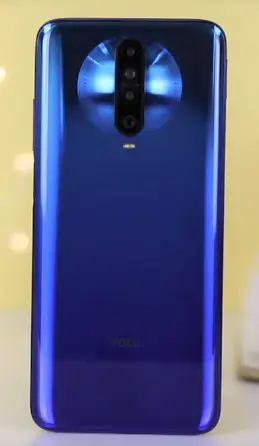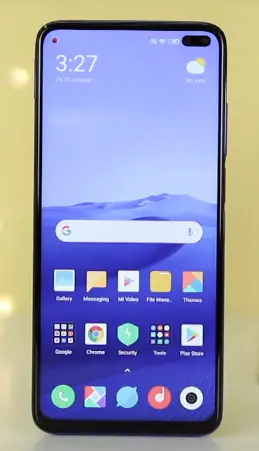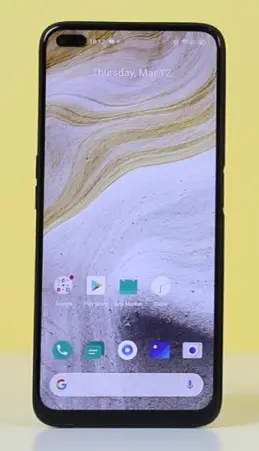Undoubtedly, the Redmi Note 9 Pro, Poco X2, and the Realme 6 Pro are some of the most popular smartphones in the sub-20K segment. And coincidentally, all the three have a fair share of similarities, including specifications and features. So, which one’s a better buy at the moment? Let’s check out the same in our detailed spec-based comparison.
POCO X2 vs Redmi Note 9 Pro vs Realme 6 Pro
Design: Glass Back & Punch Hole
For starters, the Poco X2, Redmi Note 9 Pro, and Realme 6 Pro, all three have similar design language with a few key differences in looks and build quality. The Note 9 Pro and Realme 6 Pro get polycarbonate frames, accompanied by Corning Gorilla Glass 5-protected rear. And while the Poco X2, too, gets Gorilla Glass 5, it’s packed in a sturdier aluminum frame.
The Poco X2 is available in blue, purple, and red color options without any fancy gradient effects. The same is the case with the Note 9 Pro, which comes in blue, white, and black variants. On the contrary, the Realme 6 Pro flaunts a new lightning effect and comes in two colors, including blue and orange.
The front panels of the trio have punch-hole cutouts for the selfie cameras. Realme has the dual punch-hole on the left, while Poco has it on the right side. The Redmi, in comparison, gets a single, centered punch-hole.
The Poco X2 weighs 208 grams, while the Realme 6 Pro weighs 202 grams. The Note 9 Pro stands the heaviest of all at 209 grams. Note that all three devices have splash-resistant bodies and are equipped with side-mounted fingerprint scanners.
Display: 120Hz vs 60Hz vs 90Hz
The Poco X2 features a 6.67-inch display, which is the same for Redmi Note 9 Pro. The Realme 6 Pro, in comparison, gets a slightly smaller 6.6-inch panel. All of them are IPS LCDs with Full-HD+ resolutions.
Poco has a significant advantage with its 120Hz high refresh rate screen, which makes up for smoother and snappier animations. It’s also the brightest of all and gets HDR10 support. The Realme 6 Pro isn’t very far with its 90Hz refresh rate. Unfortunately, it’s the Redmi Note 9 Pro, which loses the game with its traditional 60Hz screen.
Anyway, all three of them have Corning Gorilla Glass 5 protection upfront and support Widevine L1 certification.
Processor: SD 730G vs SD 720G vs SD 720G

Powering the Poco X2 at its core is the Qualcomm Snapdragon 730G processor. Whereas the other two are powered by Snapdragon 720G chipset, which is newer and supports NavIC. Both the chips are built on the 8nm process and are equipped with Adreno 618 GPU.
With similar processors, the three devices perform more or less similar in day to day use. However, it’s the gaming experience where the Poco X2 leads with its overclocked GPU and slightly better Kryo 470 cores, compared to Kryo 465 cores on the 720G.
As for the RAM and storage, the Poco X2 comes in 6/64GB, 6/128GB, and 8/256GB configurations. Whereas, Note 9 Pro is available in 4/64GB and 6/128GB variants. The Realme 6 Pro, on the other side, can be bought in 6/64GB, 6/128GB, and 8/128GB options.
Software
The Poco X2, Redmi Note 9 Pro, and Realme 6 Pro run the latest Android 10 out-of-the-box. Though, they do come with customized skins from their respective manufacturers.
For instance, Redmi is running MIUI 11, while Poco is using an ad-free version of the same with Poco Launcher. On the other side, Realme has packed the new RealmeUI which has a sheer advantage with its cleaner and close to stock Android experience.
Camera: 64MP vs 48MP vs 64MP Quad-setup
Like other phones in question, the Poco X2 gets quad cameras at the rear. The setup comprises a 64MP Sony IMX686 sensor, an 8MP wide-angle lens, a 2MP macro lens, and a 2MP depth sensor. Furthermore, it touts a 20MP front camera alongside a secondary 2MP depth unit.
The Redmi Note 9 Pro gets a 48MP Samsung ISOCELL GM2 sensor with an f/1.79 lens, coupled with an 8MP 120° ultra-wide-angle lens, a 5MP 2cm macro lens, and a 2MP depth sensor. There’s a single 16MP front camera for selfies.
The Realme 6 Pro, on the other hand, sports a 64MP Samsung ISOCELL GW1 sensor with f/1.8 aperture, an 8MP ultra-wide camera, a 12MP telephoto camera, and a 2MP macro camera. Upfront, you get a 16MP primary shooter, paired with an 8MP wide-angle selfie camera.
Battery: Redmi has the biggest

The Redmi Note 9 Pro gets the largest battery of all at 5,020mAh, followed by the Poco X2 at 4,500mAh, and Realme 6 Pro at 4,300mAh.
While Realme has the smallest capacity cell, it’s the fastest one to charge from 0 to 100, thanks to the 30W VOOC 4.0 flash charger. Second is the Poco X2 with 27W charging, followed by the Redmi Note, which comes bundled with a mere 18W fast charger.
Connectivity Options
The trio gets similar connectivity options, including WiFi, Bluetooth, GPS, 4G VoLTE, USB Type-C port, and 3.5mm audio jack. However, the Poco X2 gets a hybrid sim-slot, as opposed to the dedicated microSD card slot on the other two. And for those who care about IR blaster, it’s present only on the Poco and Redmi.
Price
The Poco X2 starts at INR 15,999 for the 6/64GB option. Whereas, the 6/128GB and 8/256GB models costs INR 17,999 and INR 18,999, respectively.
The Realme 6 Pro costs alike at INR 16,999 for the base variant with 6/64GB configuration, INR 17,999 for 6/128GB and INR 18,999 for 8/128GB models.
Being the cheapest of all, the Redmi Note 9 Pro is available at INR 12,999 for 4/64GB and INR 15,999 for 6/128GB configuration.
Poco X2 vs Redmi Note 9 Pro vs Realme 6 Pro: Conclusion
With Poco X2, you get a higher 120Hz refresh rate screen with better gaming performance and a better camera sensor. Whereas, at an almost similar price, the Realme 6 Pro offers faster charging, a telephoto camera, and better software experience. The Redmi Note 9 Pro, being the cheapest of all, lacks the fancy high refresh rate screen and is also the slowest charging device of the pack.
If you have no budget constraints, we’d suggest getting either of the Poco X2 and Realme 6 Pro, with the former being our primary choice here. However, if all you want is value for money without any compromise in performance, Redmi Note 9 Pro is the one to go for.







إرسال تعليق